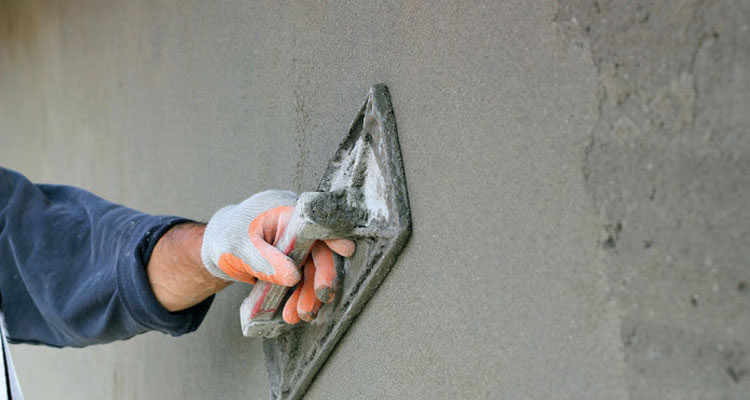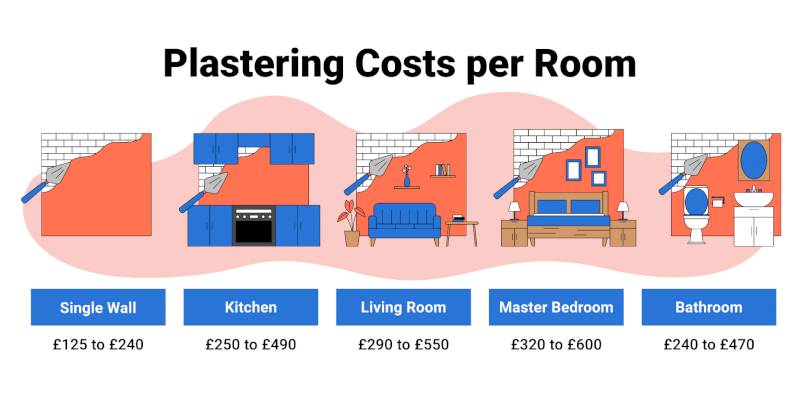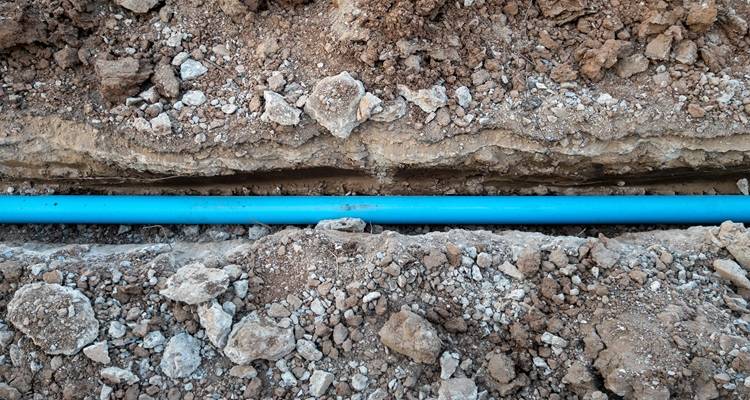Cost of Plastering a Room
- The average cost for plastering a room is £550.
- It will take roughly 2 days to complete.
- NEW! Our plastering cost calculator, which helps you to estimate how much it costs to plaster your rooms.
- A breakdown of plastering pricing information for different types of plaster.
- How long the job will take, and a general overview of what the job entails.
- How to find a local plasterer using MyJobQuote.

£550
Table of Contents
- How Much to Plaster a Room?
- Plastering vs Skimming
- Labour Cost of Plastering
- Plastering Timescales
- Factors That Impact Plastering Costs
- Finishing & Follow-On Costs After Plastering
- What's Involved in Plastering a Room?
- Decorating & Finishing Costs After Plastering
- Can I Plaster a Room Myself?
- Checklist: How To Hire a Plasterer in the UK
- FAQs
How Much to Plaster a Room?
Is your house interior plaster looking a bit tired?
Then it's probably time you renewed the plaster to provide a clean, smooth base for your decorating efforts!
But how much will it cost?
You can expect to pay anywhere between £125 and £1,500. But how much you will pay for plastering will, of course, depend on the amount and difficulty of the plastering.
For instance, a patch repair may only cost around £70 to £130, while a plaster over skim can cost anywhere from £150 to £200.
But what about plastering entire rooms?
The overall plastering cost will also depend on room size, with the cost to plaster a small room ranging from £400 to £700. This cost will rise to £800 to £1,100 for a medium-sized room, and £1,200 to £1,500 for a large room.

With skirting and architrave removed, would you expect a plasterer to skim close to the floor on a full room plaster skim?
Plastering Prices
This table sets out the different costs for various wall plastering jobs:
| Room Type | Typical Cost |
|---|---|
| Single Bedroom | £400 – £700 |
| Double Bedroom | £800 – £1,100 |
| Living Room | £1,200 – £1,500 |
| Kitchen | £900 – £1,200 |
| Plaster Patch Repair | £70 – £130 |
| Plaster Over Skim | £150 - £200 |
| Whole 3-Bedroom House | £4,000 – £7,000 |
Rooms with uneven or damaged walls, or those requiring removal of old plaster, will fall toward the higher end of the range.
If you're looking to plaster a ceiling rather than the whole room. The cost will be around £275 for an average sized room, although this can potentially rise to £1,000 depending on the total area required and if it's a straightforward job.
Plastering Cost per m²
Plastering prices are often quoted per square metre, making it easier to estimate the cost for individual walls or full rooms. For standard indoor plastering, UK rates typically range from £15 to £80 per m², depending on the type of finish, wall condition, and labour rates in your area.
As a guide:
| Type of Plastering | Typical Cost (per m²) |
|---|---|
| Skim coat over existing plasterboard | £15 – £25 |
| Full replaster (two-coat system) | £30 – £50 |
| Over old or uneven walls (extra prep) | £40 – £60 |
| Specialist finishes (e.g. Venetian plaster, lime plaster) | £100 – £250+ |
For example, a 20 m² wall (such as in a living-room) finished with a standard skim coat might cost £300 to £500 including materials and labour. Costs rise for poor-condition surfaces, curved walls, or premium finishes.
Plastering Prices: How Much To Replaster an Entire House?
The cost of plastering a 3-bed house in the UK ranges from £1,740 to £3,310, based on one bathroom, while the cost of plastering a 4-bed house in the UK (with two bathrooms) will cost between £2,300 to £4,380.
Plastering prices will differ based on individual circumstances, like the state of the property's walls, the ease of access to work on the walls/ceilings, and the geographical location, with houses in London and other large cities costing more to plaster than those in smaller towns and villages due to the increased demand.
Let's take a closer look at some plastering prices:
| House Size | Cost |
|---|---|
| One-Bed Flat (Kitchen, Living Room, 1-Bed, 1-Bath) | £1,100 – £2,110 |
| Two-Bed Terrace (Kitchen, Living Room, 2-Bed, 1-Bath) | £1,420 – £2,710 |
| Three-Bed Semi-Detached House (Kitchen, Living Room, 3-Bed, 1-Bath) | £1,740 - £3,310 |
| Four-Bed Detached House (Kitchen, Living Room, 4-Bed, 2-Bath) | £2,300 - £4,380 |
Plastering Cost Calculator
Plastering vs Skimming
If your walls are generally in good condition but you just want to improve the appearance smoothness, then they might only need to skimming rather than a full replaster.
Plastering usually refers to applying a base and finishing coat to bare walls or ceilings. Skimming is a thinner finishing layer applied over existing plaster or plasterboard to create a smooth paint-ready surface.
| Type | Description | Typical Cost (per m²) |
|---|---|---|
| Skimming | Thin coat over sound plasterboard or old plaster | £15 – £25 |
| Full Replaster | New base coat + finish coat | £30 – £50 |
Skimming is faster and cheaper, but if the wall surface is cracked or uneven, full replastering will produce a longer-lasting result.
The cost of skimming a room is normally around £400 to £500 depending on the labour rate as well as how many walls need fixing, as this will increase the overall skimming walls cost.
Patch Repair Costs
The cost of a patch repair is normally around £70 to £130, although this will depend on the extent of the job and how many walls need repairing.
If you notice any cracks in your plaster, then it may be possible to fix it by performing a blown plaster repair although you are best consulting with a professional for any advise.
A plasterer will assess whether a repair is sufficient or whether completely new plaster is required for the whole wall.
If they decide a crack repair is adequate, they will remove the damaged area and remove any dirt and debris. They will then fill the gap with a mixture of filler powder and water, and once it's dry, they will spray it with water and smooth it out with sandpaper.
Labour Cost of Plastering
How Much Do Plasterers Charge?
The average day rate for a plasterer is around £180 to £250, although plasterers in London can charge £300 per day due to higher living and operating costs.

The total cost of your plastering job is made up of two main elements, labour and materials. While most plasterers offer a fixed, all-inclusive quote, it’s still useful to understand what the labour portion looks like, especially if you’re budgeting for larger or ongoing projects.
Below is a regional breakdown of typical day rates for standard plastering jobs in the home.
| Location | Average Day Rate (Labour Only) |
|---|---|
| London & South East | £250 – £350+ |
| Midlands | £200 – £275 |
| North of England | £180 – £250 |
Some plasterers may charge by the hour instead of per day, typical rates range from £25 to £40 per hour, depending on region and skill level, but for small jobs most tradesmen tend to have a minimum charge of at least £50 (plus materials).
What Does a Plasterer’s Day Rate Cover?
A plasterer’s day rate is almost always for labour only and typically covers an 8-hour workday. Always clarify what’s included before starting the job. The following items are often not included in a standard day rate and may be charged separately:
- Materials: Plaster, plasterboard, corner beads, and PVA primer.
- Waste Disposal: Skip hire or removal of old plaster may add £50 to £150.
- Access Equipment: Scaffolding or tower hire for high ceilings or stairwells.
- Minimum Charge: Small patch repairs often incur a call-out fee starting from £50 plus materials.
- VAT: Always confirm if VAT (20%) is included when comparing quotes.
Labour-Only Cost Estimates Per Job
The figures below exclude materials, for full project totals, see our plastering costs by room and cost per m² sections above. These prices reflect typical labour time rather than a strict daily rate.
| Job Description | Labour Only (Estimated) |
|---|---|
| Small Room (e.g., Box Room) | £150 – £300 |
| Medium Room (e.g., Double Bedroom) | £250 – £400 |
| Large Room (e.g., Living Room) | £350 – £500 |
| Plaster Patch Repair (Minimum Charge) | £50 – £90 |
| Plaster Over Skim (Small Room) | £120 – £180 |
Plastering Timescales
The above costs will, of course, depend on how long the job is estimated to take. This is also important to factor in when it comes to any disruption ot your week. The following is to give an estimate, although the actual duration can vary from job to job..
| Job Description | Estimated Timescale |
|---|---|
| Small Room | 1 day |
| Medium Room | 1–2 days |
| Large Room | 2–3 days |
| Plaster Patch Repair | 1 day |
| Plaster Over Skim | 1–2 days |
Factors That Impact Plastering Costs
To help you get a better idea of plastering prices, take a look at the following cost factors, which will allow you to configure a better estimate:
Type of Plaster
The type of plaster used can slightly affect the overall cost of your job, but it’s usually a small factor compared to labour, room size, and preparation. The price difference per room might only be in the region of £5 to £10.
Most projects will use an undercoat plaster for walls and a topcoat or skim plaster for a smooth finish. Specialist plasters, such as those for damp-treated walls or patch repairs, can increase labour slightly but the material cost is typically minimal. Your plasterer will usually choose the appropriate plaster based on the surface and desired finish.
Size of Area
The majority of plasterers on per square metre, so the larger your wall is, the more you will pay.
To work out a more accurate price use our calculator, or you could measure the height and width of your wall and multiply it by the cost.
Number of Walls
Another important factor is how many walls require plastering, as again, the more space that needs work, the more expensive it will be.

For instance, if you just need one wall plastering, then you should expect to pay around £150 to £300, while an entire room with four walls could range from £190 to £600.
Old Surface Removal or Preparation Work
If your walls or ceilings have an existing finish (e.g. Artex, lath & plaster, stripped plaster), expect additional labour and disposal costs. Older homes often require this extra work, increasing cost due to time and complexity.
Location of Property
Your property's location is also a contributing factor, as tradesmen will charge different rates depending on how far they have to travel, so if you live in a remote area, you may have to pay more.
Plasterers in London will also charge a lot more than tradesmen in the surrounding areas due to the increased demand.
Ease of Access
When plasterers price up a job, they will consider the level of access to the area they are plastering. This is especially true when working on a property with high walls and hard-to-reach ceilings, as this will make the job more difficult to complete and as such, they'll likely charge more because of it.
As an estimate, if you are just having the ceiling plastered, you can expect to pay somewhere between the cost of a touch-up and that of doing the whole room. Although as a general rule, the higher the ceiling, the more it's likely to cost.
How much does it cost to plaster a room size 5m x 5m, including ceiling and walls?
Finishing & Follow-On Costs After Plastering
Beyond the base cost of plastering your walls, there are a number of extra items you may need to budget for. These are not guaranteed on every job but can significantly affect the overall spend:
Skip Hire & Waste Disposal
If your job involves removing old plaster, lath & plaster ceilings, large amounts of rubble or waste, you’ll likely need a skip or waste removal service. In the UK, skip hire typically ranges from £70 to £300 per week depending on size, location and permit requirements. Permit fees may add £15-£50 if needed.
Decorating Readiness / Finish Level
If you require a decorator-ready finish (skimming, rapid drying, immediate painting), or the plaster needs to be hand-polished to a premium standard, this may increase labour and finish costs. It’s a good idea to ask “in what condition is the wall when you hand it back?”
Drying Time & Rush Jobs
If you expect the room to be used or decorated immediately after plastering, or you need the job completed in a tight schedule, the plasterer may charge more to cover drying aids or accelerated work. Delayed drying can lead to decorating delays and additional costs too.
Damp or Moisture Treatment
If your walls show signs of rising or penetrating damp, or you are replastering after moisture damage, you may need specialist treatment. This can add an extra £500 to £2,000 depending on the size of area and severity. Always ask whether damp-proofing or removal of damaged plaster is included in the quote.
What's Involved in Plastering a Room?
If you have never had your walls plastered before, it can prove to be a more complex job than you may realise. Especially if you're considering going down the DIY approach, as a professional has far more experience and know-how to ensure the work is completed properly.
With this in mind, it's recommended to ask for a quote from several different companies or individuals. Here at MyJobQuote, we can help you get quotes from plasterers near you for free, with no obligation to to go ahead.
The following step-by-step guide will help you understand how a professional plasterer will complete the job:
Before Plastering the Walls
- Protecting the Room — The first thing that a professional plasterer should do is lay down dust sheets to protect your floor and other furnishings. This will also collect any debris while preventing it from sticking to the plaster, ensuring a smooth and clean surface.
- Removing Old Plaster — Once the dust sheets are set out, the plasterer will proceed to remove any old plaster rather than just re-plastering, as this will ensure the work lasts longer. They may use a drill, chisel, or hammer carefully to prevent damage to the walls.
- Priming the Walls — After all the old plaster is removed, along with any dirt and debris, the plasterer will prime the walls by diluting and brushing PVA onto them. This enables the plaster to be applied immediately and allows it to dry evenly.
- Mixing the Plaster — Most plasterers mix their plaster on-site, choosing either a traditional wet plaster or dry-lining boards. Wet plaster offers a smooth, durable finish, while dry-lining is quicker and reduces cracking.
During the Job
- Applying the Plaster — The plaster is typically applied in two coats to replace the existing surface and create a flat, even wall.
- Skimming and Smoothing — After the first coat is applied, the plasterer waits about 20 minutes for it to dry slightly. Then, using a trowel, they even out bumps and smooth corners at the top and bottom of the wall.
- Scraping the Surface — While some plasterers skip this step, scraping with a devilling float—a wooden tool with nails—can remove small lumps to ensure a perfectly smooth surface.
- Applying Another Layer — Once the first layer is dry, the plasterer applies a second, thinner finish coat. Applied skillfully, this results in a perfectly flat, smooth wall.
After Plastering the Walls
- Finishing Up — To finish, the plasterer sprays the edges with water and smooths the surface with a trowel or wet brush. When set, the plaster becomes an integral part of the wall, ready to be painted or wallpapered.
- Clearing Up — Any reputable labourer will happily clear up after themselves, removing any dust sheets and other protection before tidying up any debris and removing waste.
Decorating & Finishing Costs After Plastering
There are various other jobs you need to consider when hiring a professional to plaster your walls, including:
Painting a Room
After your walls have been plastered by a qualified plasterer, you may choose to have them painted, which will involve hiring a professional painter. The cost to paint an entire room with two coats of emulsion is around £400, although you should wait at least a week after plastering to ensure the walls have dried sufficiently.
However, you may be able to paint earlier than this if your plaster has quick-drying qualities. Before painting, you should always check on the manufacturer's instructions or ask a qualified plasterer.
The cost may vary depending on the type of paint you choose, as some are much harder to apply than others. The existing state of your walls will also determine the price you pay, with damaged walls requiring repair costing more.
I have used watered-down emulsion to paint new plaster, but it was silk. It said on the tin that it could be watered down 10% to seal new, porous surfaces, but I have since read it must be matt. Have I ruined my plaster?
Wallpapering
If you prefer wallpaper to paint, then you may want to pay an experienced decorator to hang your chosen wallpaper. The typical price for hanging wallpaper on a newly plastered wall is around £300 to £730.
Again, the overall price will depend on the wallpaper you choose, as some wallpaper types are a lot harder to fit, as are ones with large pattern repeats.
Fitting Wall Panelling
Perhaps you want to achieve a completely different look, and move away from painted or wallpapered walls - which is where wall panelling can be appealing. The cost of wall panel installation varies greatly based on the size of the room, type of wood, and desired design, but is typically around £425 for an average-sized room using mid-market materials, taking 1 to 3 days to complete.
This is a task you can DIY if you have the tools and are happy to give it a go. You can fit the wooden strips yourself, and then paint them to your desired colour.
Replacing Skirting Boards and Architraves
Once your walls are smooth, other less-smooth areas can begin to become more obvious - and if your room's old skirting boards and architraves look worse for wear, it can be hard to ignore. Again, this is a job you can attempt yourself if you have the right tools and mindset, with supply costs starting at £8 per length.
However, if you'd prefer to hire a carpenter to get the job done for you, you can expect the cost of new skirting boards to be around £250 for supply and installation.
Installing Light Fittings
If you've had your ceiling replastered, you may want to finish off the space with a new light fitting installation. The cost of installing a new light fixture ranges from £100 for a simple like-for-like fitting swap with no additional wiring, whereas more extensive installations can cost upwards of £650 for a 6 lamp lighting grid in the kitchen.
Installing New Electrical Sockets
Replastering a room can give you a completely blank canvas to essentially start again - which means you get to choose where electrical sockets should be. The cost of installing a new single plug socket is £50 for supply and installation, while double plug sockets with USB slots cost closer to £60.
Can I Plaster a Room Myself?
Plastering is one of the trades where it is almost always better to get a professional to carry out the work for you. It is also a physically draining and highly skilful trade, which is best left to the professionals unless you have some prior plastering experience.
A plasterer will usually be able to finish the job far quicker than you will and will provide a much better finish. Also, some jobs may require special tools or knowledge that you simply do not have.

What type of plastering can you try as a DIY project?
You might be tempted to plaster yourself if you only need to skim a small wall where aesthetics are not really important, for example, to a wall which will be mostly concealed by wardrobes or other furniture.
However, if the wall is visible and requires a smooth and professional finish, then this is normally far beyond the capabilities of most DIY enthusiasts.
I've had a bedroom wall reskimmed, just wondering what sort of paint I need to use on a newly skimmed wall, and what sort of primer needs to go on first?
Checklist: How To Hire a Plasterer in the UK
Before hiring a plasterer, you should consider the following checklist to ensure you employ the right person for the job:
- Do they hold a Level 2 NVQ in Plastering? This is a recognised qualification, showing they’ve had proper training and assessment, which alongside several years of hands-on experience can ensure you're hiring a suitable tradesmen.
- Are they a member of an accredited scheme? For example, the British Gypsum Certified Plasterer Scheme recognises reliable and skilled professionals.
- Do they have public liability and employer’s liability insurance? This protects you in case of accidents or damage during the job.
- Can they show examples of previous work? Ask to see photos, a portfolio of work or provide details of recently completed jobs so you can assess the quality for yourself.
- Do they have positive reviews or recommendations? Check on MyJobQuote for customer feedback of similar work from other homeowners, or ask friends and family for personal recommendations.
- Have you compared at least 3 quotes? Requesting multiple quotes through MyJobQuote can help you gauge if you are being offered the work at a fair price and can help ensure you avoid overpaying.










